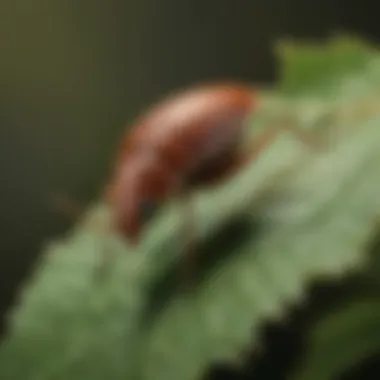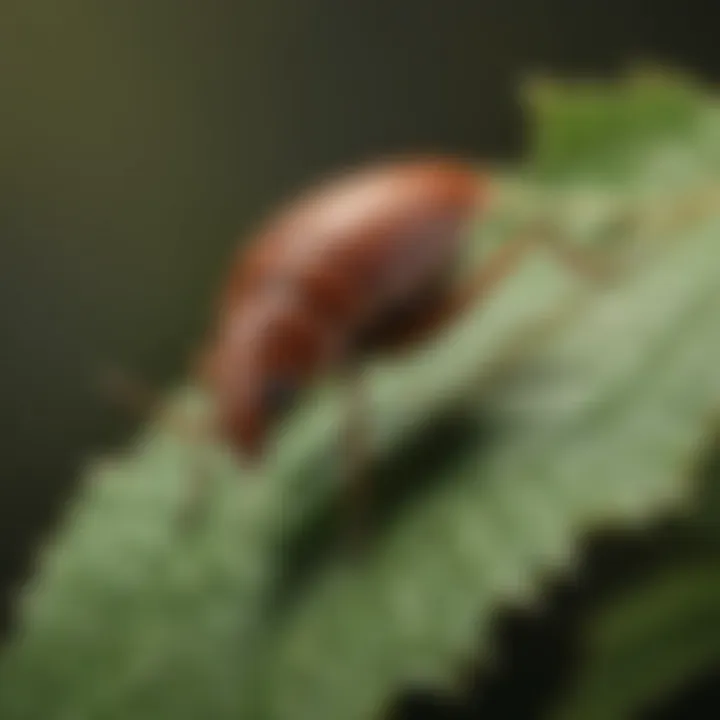Effective Strategies for Controlling Elm Seed Beetles


Understanding Woodland Ecosystems
In the realm of forestry, understanding woodland ecosystems forms the bedrock for addressing challenges like the elm seed beetle infestation. Woodlands serve not just as a backdrop to life, but they are vibrant organisms themselves, rich in biodiversity. The intricate connections between various flora and fauna result in ecosystems that can maintain balance when functioning optimally.
Importance of Biodiversity in Forests
Biodiversity within forests is more than a collection of various species. Each type of tree, insect, bird, and plant possesses unique roles that contribute to the health of the ecosystem. For instance, a diverse tree canopy provides habitat for myriad organisms. It also encourages competition among species, which, while seemingly harsh, results in a more robust ecosystem that can better withstand crises such as the infestation of pests like the elm seed beetle. Ultimately, promoting diversity leads to resilience in the face of adversity, ensuring that no single species dominates at the expense of others.
Role of Forests in Climate Regulation
Forests play a pivotal role in regulating our climate. Actively absorbing carbon dioxide, they act as carbon sinks, mitigating climate change effects. Trees in these ecosystems release oxygen and moderate temperatures, creating micro-climates that benefit not only plant and animal life but also human habitation nearby. When pests like the elm seed beetle threaten these trees, their ability to perform these essential functions diminishes, leading to wider environmental repercussions.
"A healthy forest is a self-supporting system; when one part suffers, others feel the impact."
Sustainable Forestry Practices
To address issues like the elm seed beetle, sustainable forestry practices emerge as a crucial strategy. These practices are founded on principles that aim to balance resource extraction with ecological stewardship. It's about finding a harmony that benefits both the forest and us.
Principles of Sustainable Forestry
- Long-Term Planning: Sustainability requires foresight. Forests should be managed with future generations in mind, ensuring resources are available long-term.
- Ecosystem Maintenance: Keeping the ecosystem intact is of paramount importance. This involves protecting flora and fauna diversity and maintaining the quality of soil and water in the region.
- Adaptive Management: Strategies must evolve based on changing conditions. Monitoring the health of the forest and responding to emerging threats like pest infestations is necessary.
Case Studies of Successful Implementations
Several examples show how sustainable practices have been effective:
- In Finland, initiatives focused on selective logging and natural regeneration have increased biodiversity and reduced pest populations.
- In Canada, community-driven reforestation efforts have not only supported timber resources but have also improved forest health and resilience against pests.
Woodland Stewardship Techniques
Effective control of pests like elm seed beetles requires robust woodland stewardship techniques. Properly managed forests can mitigate these threats and foster a thriving ecosystem.
Forest Management Plans
Creating a solid forest management plan is central to successful stewardship. Such plans should involve:
- Regular Monitoring: Keep tabs on beetle populations and other pests.
- Integrated Pest Management: Combine various control tactics such as biological, mechanical, and chemical methods to manage pests responsibly.
Conservation Strategies
Conservation strategies are essential for protecting forest ecosystems. This could involve:
- Setting aside protected areas where pests are less likely to spread.
- Education programs aimed at increasing awareness about the importance of biodiversity and effective pest control methods.
Understanding woodland ecosystems and adopting sustainable practices are foundational to tackling the challenges posed by elm seed beetles. In this journey of stewardship, each careful step not only aims to protect beloved trees but also ensures the vitality of the larger ecosystem as a whole.
Preface to Elm Seed Beetles
Understanding elm seed beetles is essential for anyone involved in woodland management. These little beetles, while small in size, pack a punch when it comes to their impact on elm trees and the broader ecosystem. By diving into their behavior, life cycle, and geographical presence, stakeholders can adopt effective strategies to mitigate damage.
The elm seed beetle is more than just a pest; it’s a critical piece of the puzzle in maintaining ecological balance. Elm trees often serve as focal points in many landscapes, providing not just shade and beauty but also functioning as important habitats for various species. If these beetles spiral out of control, they can cause significant harm, leading to the deterioration of these majestic trees.
In this section, we focus on identifying elm seed beetles, a crucial step towards managing their populations effectively. Armed with knowledge about what these pests look like, forestry professionals can better assess their presence and take timely actions. Additionally, recognizing their distribution across different regions allows for strategic planning and coordination, both of which are vital in pest control endeavors.
"Knowledge is power; understanding the foe is the first step to winning the battle against pests."
Identification of Elm Seed Beetles
Identifying elm seed beetles involves careful observation, as their appearance can be easily mistaken for other beetles. Typically, these beetles are small, generally about 3 to 5 mm long, and have a somewhat elongated shape. They exhibit a distinctive dark brown to black coloration, with a slight metallic sheen that becomes more visible when light strikes them at the right angle.
Key features that set them apart include:
- Shape: Elongated with a smooth surface.
- Color: Dark brown to black with metallic hues.
- Thorax: Rounded, giving a somewhat robust appearance despite their small size.
Recognizing their larvae is just as important. The larvae are creamy white in color and are legless, which can make them challenging to spot since they tend to inhabit the seeds and pods of elm trees where they are less visible to predators.
Effective identification not only aids individual management efforts but also helps in sharing information within the community regarding sightings and potential infestations.


Geographic Distribution
Elm seed beetles are primarily found in regions where elm trees are abundant. Their presence spans across North America and large swathes of Europe, making their habitat quite extensive. In North America, states like New York, Illinois, and Indiana see considerable populations due to the high availability of elm trees in these areas.
Factors contributing to their distribution include:
- Climate: Warmer climates tend to favor beetle reproduction and survival.
- Host Availability: Proximity to elm trees is crucial for their life cycle as the trees provide food and breeding grounds.
Understanding where these beetles thrive allows professionals to concentrate their control efforts effectively. Mapping the distribution also assists researchers and land managers in anticipating outbreaks and implementing proactive measures.
By being aware of elm seed beetle characteristics and their geographic range, the groundwork is laid for strategic control measures that can ultimately protect elm trees and the ecosystems they support.
Life Cycle and Behavior of Elm Seed Beetles
Understanding the life cycle and behavior of elm seed beetles is critical in tailored strategies for their control. By grasping the nuances of their development and patterns, forestry professionals gain insights into timing interventions. For instance, the beetles' life stages dictate when they are most vulnerable, aiding in selecting the optimal control methods. Knowing how these pests behave not only informs immediate action but also shapes long-term management strategies in maintaining healthy elm tree populations.
Development Stages
Elm seed beetles undergo a complicated life cycle, consisting of four main stages: egg, larvae, pupae, and adult. Each stage is pivotal in understanding both their increasing numbers and susceptibility to control measures.
- Egg Stage: The female beetle lays eggs on the seeds of elm trees. This stage lasts about a week, depending on temperature and humidity. Environmental conditions play a big role here; warmer weather tends to hasten egg development.
- Larval Stage: After a week, the eggs hatch into larvae, which burrow into the seeds. This can last several weeks. It's crucial to note that these larvae, feasting inside the seeds, cause significant damage to the potential growth of elm trees.
- Pupal Stage: Once they mature, larvae transform into pupae. This stage is a sort of wildlife pause, where their body structures undergo dramatic changes. The duration ranges from a few days to a couple of weeks, influenced by external factors like temperatures.
- Adult Stage: Finally, they emerge as adults, ready to mate and begin the cycle anew. Adult beetles are typically active in the spring and summer months, with mating and egg-laying cycles repeating several times.
Understanding these stages offers a strategic advantage—whether it's targeting sprays to coincide with larval emergence or planning cultural practices when adult beetles are most active.
"Control measures should align with the pests' biological cycles for effectiveness."
Feeding Habits
The feeding habits of elm seed beetles are equally critical to investigate. They primarily feed on the seeds and flowers of elm species. Their feeding not only destroys elm seeds but also diminishes the reproductive capability of the trees.
- Seed Consumption: The larvae consume seed tissue as they develop, leading to a reduction in availability of viable seeds. This impacts the overall growth and regeneration of elm trees over time.
- Adult Feeding: Once they reach adulthood, beetles may chew on leaves, although their primary focus remains on the seeds. This can lead to noticeable defoliation, worsening the health of already stressed trees.
- Nutritional Needs: Elm seed beetles are attracted not only to the nutritional value of elm seeds but also to the moisture content in the seeds. Thus, priority should be given to managing moisture levels in the vicinity of these trees to discourage attracting these beetles.
These feeding habits underscore why it’s important to consider ecological, environmental, and biological factors in any pest management plan. The knowledge of life stages and feeding habits facilitates informed decisions that can help mitigate the impacts of these beetles on elm trees and maintain biodiversity in local ecosystems.
Impact of Elm Seed Beetles on Ecosystems
The affect of elm seed beetles on various ecosystems extends beyond the immediate damage inflicted upon trees. These beetles play a crucial role in the ecological balance of their environment. Understanding their impact helps forestry professionals devise strategies for management and prevention. Their presence can indicate broader ecosystem health issues, meaning monitoring them isn't just about happy trees, but about preserving the intricate web of life they support.
Damage to Elm Trees
Elm trees are key players in many forest ecosystems, providing habitat and food for various species. However, elm seed beetles have a not-so-subtle way of making their presence known. Their larvae tunnel into the seeds of elm trees, leading to significant damage. When the seeds are compromised, it poses a risk to future generations of elms, which can drastically reduce their population over time.
- Seed Destruction: The larvae feast on the seeds, leaving them unviable. This can stunt forest regeneration.
- Tree Health: Infested trees may become more susceptible to diseases and pests. Weakened trees can't resist environmental stresses effectively.
- Economic Impact: For landowners or municipalities, damaged trees mean costs related to removal or replacement, impacting budgets.
As these trees struggle to survive, the entire forest ecosystem can feel the pressure. Other organisms that rely on healthy elm populations may also be adversely affected, contributing to a cascading effect throughout the ecosystem.
Effects on Biodiversity
Biodiversity is the lifeblood of any ecosystem. When elm seed beetles wreak havoc on elm tree populations, it indirectly alters the biodiversity of the area. Many species, from insects to birds, depend on elm trees for shelter and food. The decline of elms can therefore lead to a domino effect on these species.
- Food Chain Disruption: Birds and insects that rely on elm seeds might find themselves searching for alternatives, which could disrupt the food chain.
- Habitat Loss: As elm trees disappear, the niches they provide are lost, affecting numerous species that depend on them.
- Pollinator Impact: Elm trees also provide pollen, and their reduction can impact pollinator populations, which are essential for many other plants.
"The decline of a single species can create a ripple effect, threatening the very fabric of an ecosystem."
Maintaining the health of elm trees is not simply about conserving one species; it's about ensuring the survival of the interconnected population that forms our ecosystems.
Addressing the impact of elm seed beetles is fundamental in maintaining biodiversity and ecological stability. The implementation of effective control methods, better monitoring systems, and community involvement in conservation efforts can work together to mitigate these beetles' negative effects.
Control Methods for Elm Seed Beetles
Controlling elm seed beetles is a challenge that requires a multifaceted approach. A diverse range of methods exists to mitigate the impact of these pests, and understanding their specifics is key. Effective control methods not only help in minimizing damage to elm trees but also contribute to the overall health of the ecosystem. This section delves into the various techniques, highlighting their importance, benefits, and considerations.
Chemical Control Techniques
Chemical control methods involve the application of insecticides to reduce the population of elm seed beetles. These pesticides can be effective, especially when targeting specific life stages of the beetles. When considering chemical treatments, it's vital to choose insecticides that are not only effective but also environmentally friendly. Here are some points to keep in mind:
- Efficacy: Select products that have been tested and proven effective against elm seed beetles. Look for active ingredients like imidacloprid or pyrethroids, which have shown promise in various studies.
- Application Timing: Timing is everything. Apply chemicals when beetles are most vulnerable, often during their emergence or active feeding stages.
- Resistance Management: Be aware that overuse of the same chemicals can lead to resistance. Rotate between different classes of insecticides to maintain effectiveness.


"The key to successful chemical control lies in informed choices and timely applications."
Biological Control Agents
A more sustainable approach involves utilizing biological control agents such as natural predators or pathogens to keep elm seed beetle populations in check. These methods not only provide an environmentally friendly solution but also promote biodiversity. Some avenues to explore include:
- Predators: Introducing predator species, such as certain birds, tiny parasitic wasps, or beneficial nematodes, can help manage beetle populations. Understanding the ecology of these predators is vital to ensuring they thrive in your ecosystem.
- Pathogens: Utilizing entomopathogenic fungi or bacteria can provide an alternative means to combat beetles. For instance, Beauveria bassiana is a fungi that infects various beetles and can be applied to affected trees.
- Companion Planting: Some plant species can attract beneficial insects that prey on beetles. For example, planting dill or coriander may attract ladybugs, which feast on pests.
Cultural Practices
Cultural practices involve changing the environment to make it less hospitable for elm seed beetles. This can significantly reduce their populations over time. Consider the following strategies:
- Sanitation: Remove fallen branches, decaying wood, and other debris that could harbor beetle larvae. Keeping the area clean reduces breeding grounds.
- Diversity in Plant Selection: Implementing a diverse range of tree species in your garden or woodland can limit beetle invasions by promoting healthy competition among various plants.
- Regular Monitoring: Keep a close eye on elm trees for early signs of beetle activity. Regular inspections can help catch infestations before they escalate.
Integrating Pest Management Strategies
Integrating Pest Management Strategies, often known as IPM, is a critical approach for managing elm seed beetle populations effectively. The essence of IPM lies in its holistic view—considering not just the pests involved but also the broader ecosystem dynamics. This method allows for a nuanced understanding of pest behavior, enabling practitioners to deploy strategies that minimize disruption to the environment while maximizing control effectiveness.
By using a combination of biological, chemical, and cultural practices, forestry professionals can ensure that their efforts to combat elm seed beetles are sustainable and efficient. Incorporating IPM strategies can bring about significant benefits, such as reduced pesticide use, cost-effectiveness, and lower risks of pest resistance.
This approach emphasizes the importance of monitoring and forecasting pest populations. By regularly observing beetle activity, professionals are more equipped to make informed decisions. To summarize, the integration of multiple strategies forms the core of an effective long-term pest management plan, ultimately contributing to the health of elm trees and their surrounding ecosystems.
Understanding Integrated Pest Management (IPM)
Integrated Pest Management is an adaptive management strategy that fuses various control techniques with the goal of sustainable pest control. It differs from traditional pest management by not relying solely on chemical pesticides; instead, it employs an array of tactics, such as biological control using natural predators, habitat manipulation, and cultural practices like crop rotation.
The key to successful IPM lies in its principles:
- Preventive Measures: By creating conditions that are less favorable for elm seed beetles, such as optimizing soil health and promoting tree resilience, the chances of an infestation can be significantly reduced.
- Monitoring & Identification: Regularly checking for pest signs is paramount. Early identification allows for preventive or reactive measures to be put in place before populations explode.
- Thresholds: Understanding the tolerable levels of these beetles is essential. It’s not feasible to eliminate every single pest; instead, manage populations to below thresholds where they cause significant harm.
- Ecological Balance: IPM recognizes the importance of maintaining ecological balance. The use of beneficial insects to manage beetle populations allows for a natural form of control, which in turn sustains biodiversity.
By having a thorough understanding of these principles, professionals can tailor an IPM approach that fits the specific needs of their ecosystem, ensuring elm trees remain healthy while keeping beetle populations manageable.
Monitoring and Forecasting Techniques
Monitoring and forecasting are indispensable components of a robust IPM program. These techniques allow professionals to gather data on elm seed beetle populations and predict their outbreaks before they become widespread.
Monitoring Techniques:
- Visual Inspection: Regular checking of trees and surrounding areas for signs of elm seed beetle activity. Understanding where they are prevalent can guide intervention strategies.
- Traps: Using pheromone traps can provide insight into the population levels and movement. These traps not only capture specimens but also help in gauging attraction, which informs future control measures.
- Field Surveys: Conducting systematic surveys enables the collection of comprehensive data that can drive effective management decisions.
Forecasting Techniques:
- Weather Data: Understanding the climatic conditions that favor beetle life cycles is vital. Warmer temperatures might accelerate their development, prompting proactive measures.
- Degree Day Models: Employing degree day calculations helps predict phenological events, meaning when beetles are likely to emerge, mate, or lay eggs.
- Historical Data: Analyzing past beetle population dynamics can help in making informed predictions about future outbreaks.
Effective monitoring and forecasting not only mitigates damage but also secures the long-term health of elm trees and the forests they inhabit.
Preventative Measures to Mitigate Elm Seed Beetle Populations
Adopting preventative measures to manage elm seed beetle populations is paramount for preserving elm trees and maintaining ecological balance in woodland areas. Prevention not only curtails the pest's lifecycle but also shields the trees from the extensive damage these beetles can inflict. Prevention strategies are often more cost-effective than reactive measures, making them a cornerstone of effective woodland management.
Several specific elements come into play when discussing these preventative approaches:
- Plant Selection and Diversity
Planting a variety of tree species can disrupt the life cycle of elm seed beetles. By providing diverse habitats, it becomes hard for these beetles to establish dominant populations. Besides, introducing native plant species is a broad best practice; they tend to support healthy ecosystem dynamics and can attract beneficial insects that prey on these pests. - Garden and Woodland Maintenance Tips
Regular maintenance of woodlands and gardens is a key measure. This involves not just caring for elm trees, but also keeping an eye on the overall health of the surrounding ecosystem. Healthy trees can better withstand pest attacks, and well-maintained habitats can limit beetle proliferation.
The success of these preventative methods hinges on timeliness and vigilance. Being proactive means regularly inspecting woodlands, monitoring beetle populations, and responding with appropriate measures before a problem escalates. Implementing these strategies requires collaboration among community members, leading to a more effective approach against elm seed beetle populations.
“The best defense often starts before the trouble arrives.”
In summary, preventative measures not only protect individual elm trees but also enhance the resilience of entire ecosystems. Such strategies reinforce the need for forestry professionals to advocate for and implement multi-faceted approaches when managing these pests. This proactive stance, grounded in informed choices and diligent care routines, is essential for sustaining the health of elm populations and the biodiversity they support.
Plant Selection and Diversity
Choosing the right plants can spell the difference between a thriving garden and one plagued by pests. When selecting trees and shrubs for areas inhabited by elm seed beetles, consider integrating a mix of native and ornamental species.
Diversity offers multiple benefits:
- Decreases monoculture conditions that allow pests to thrive.
- Provides habitats for natural predators of the beetles, leading to natural pest control.
- Enhances the aesthetic value of the landscape, making it not only functional but visually appealing.


Additionally, it's wise to consult local agricultural extension offices to identify the best plant varieties suited for your particular soil and climate. This effort can yield not just resilience against elm seed beetles but overall improved health for your trees and shrubs.
Garden and Woodland Maintenance Tips
Regular maintenance is crucial for keeping environments less hospitable to elm seed beetles. This entails various actions, ranging from simple observation to more intensive care routines:
- Regular Inspections: Inspect elm trees routinely for signs of beetle activity, such as tunneling or leaf discoloration. Early detection often leads to easier control.
- Proper Pruning: Pruning diseased or dead branches not only supports good tree health but also removes potential nesting sites for beetles.
- Clean Surroundings: Clear away fallen leaves, twigs, and other debris where beetles could harbor.
- Soil Health: Promote soil health by ensuring adequate drainage and avoidance of compaction. Healthy soils lead to robust trees capable of resisting pest attacks.
By embracing a holistic approach to garden and woodland maintenance, you encourage a balanced ecosystem, making it increasingly difficult for elm seed beetles to thrive. Maintaining such an environment fosters resilience and reduces the need for chemical interventions later down the line.
Community Involvement and Educational Outreach
Engaging the community in efforts to control elm seed beetles is vital for both effective management and educational growth in forestry practices. The more people understand the issues surrounding these pests, the better prepared they will be to contribute to solutions. Community involvement fosters a sense of ownership and responsibility toward local woodland health, which can lead to more proactive measures and overall better ecological practices.
Educational outreach plays a dual role: it provides information about elm seed beetles and ways to control them while also raising awareness about the importance of biodiversity and ecosystem integrity. Through these efforts, communities can develop stronger connections to their local environment and gain insight into the delicate balance required to sustain it. Such awareness often translates into informed action that can yield significant benefits in pest management.
Engaging Local Communities
A strong communal approach can dramatically enhance the effectiveness of elm seed beetle control strategies. By bringing people together, local groups can create a network that shares knowledge, resources, and labor. This could involve various activities, such as:
- Establishing Neighborhood Watch Groups for Pests: Residents can monitor their areas for signs of beetle infestation and report findings to local authorities or ecological organizations.
- Community Cleanup Days: Organizing events to clean up local woodlands can educate participants about the habitat these insects rely on while simultaneously reducing potential breeding grounds.
- Promoting Native Plant Gardens: By encouraging the planting of native flora, communities can create environments less conducive to pests, thereby reducing their likelihood of encroaching on elm trees.
The aim is to make pest control a community responsibility. When residents feel invested, they are more likely to participate actively in monitoring and advocacy.
Workshops and Training Sessions
Workshops and training sessions serve as excellent vehicles for transferring knowledge about elm seed beetles to the community. These events can cover a range of topics, from identification to management strategies. Here are some key elements that can be included:
- Basic Identification Skills: Teaching participants how to identify elm seed beetles and their damage empowers them to act quickly, limiting infestations before they become too severe.
- Hands-On Management Techniques: By demonstrating chemical and biological control methods, residents can learn best practices directly from experts. Practical demonstrations can demystify techniques that might seem daunting at first.
- Sustainable Gardening Practices: Workshops can highlight practices that not only control pest populations but also foster biodiversity, including crop rotation, companion planting, and maintaining soil health.
"Knowledge isn’t just power; it’s a dance that flows through the hands of those who dare to engage with their environment."
In these workshops, local experts can collaborate with seasoned forestry professionals to offer residents a well-rounded perspective. Engagement also benefits attendees by providing them with actionable strategies they can implement in their own backyards, creating a ripple effect of knowledge and action that extends far beyond the workshop's walls.
Ultimately, educational outreach centered on community engagement creates a proactive rather than reactive approach to pest control, ensuring that elm seed beetles are managed effectively while fostering a culture of awareness and care for the local environment.
Future Research Directions in Beetle Control
The management of elm seed beetles cannot rest on established methods alone. Continuous advancements in research offer insights into more effective strategies. This section delves into crucial areas of future research that can enhance our understanding and control of these problematic pests. By focusing on specific innovations and insights from long-term studies, forestry professionals can better prepare and implement strategies for sustainable woodland management.
Innovative Control Technologies
The integration of technology into pest management is not just a trend—it's becoming a necessity. Research into innovative control technologies is paving the way for smarter and more efficient management practices. Here are key points worth considering:
- Remote Sensing Techniques: Tools like drones equipped with high-resolution cameras can survey large forested areas. They help identify infested trees before the damage becomes severe. Such imagery can be invaluable in planning targeted interventions.
- Smart Traps: Novel trapping systems are in development that uses pheromones or visual cues to attract beetles. Coupled with sensors, these traps can provide near-real-time data on beetle populations, aiding in swift responses.
- Genetic Studies: As researchers unlock the genetic makeup of elm seed beetles, it opens avenues for more targeted biocontrol methods. This could include the development of traps or bioinsecticides aimed specifically at life stages most vulnerable to threats.
By exploring these technologies, we can build a future where beetle populations are managed more intelligently, reducing reliance on chemical interventions and minimizing ecological impact.
Long-term Ecological Studies
Understanding the full ecological consequences of elm seed beetle infestations necessitates long-term ecological studies. Such research provides a comprehensive view of the interactions between beetles, their host trees, and associated biodiversity. Here are several aspects to consider:
- Life Cycle Analysis: Long-term studies can document how changes in climate and environment affect beetle development cycles. Knowing their patterns helps in forecasting potential outbreaks and timing management practices accurately.
- Biodiversity Impacts: The consequences of elm seed beetles on broader ecosystems can be profound. Long-term ecological studies can reveal shifts in species interactions, tree health, and overall biodiversity. Recognizing these links enables forestry professionals to take a holistic approach to management.
- Ecosystem Services Assessment: Evaluating how elm seed beetle control efforts affect ecosystem services—like carbon sequestration and water regulation—gives insight into the broader implications of management practices. This understanding helps inform policies and practices that marry ecological integrity with pest control.
In summary, engaging in these innovative control technologies and investing in long-term ecological studies is essential as we aim to safeguard the health of our woodlands while effectively managing elm seed beetle populations. This commitment to research will enhance our ability to respond to future challenges in forest management, ensuring a resilient ecosystem for generations to come.
"Innovative strategies combined with rigorous ecological studies lay the foundation for effective long-term management of pests like the elm seed beetle."
- Expert in Forest Ecology
End
The key elements of controlling elm seed beetles include a multifaceted approach:
- Chemical Control Techniques: Utilizing targeted pesticides when necessary can offer quick relief from infestations. However, caution must be exercised to avoid harming beneficial insect populations.
- Biological Control Agents: Introducing natural predators can provide a sustainable long-term solution, reducing the dependency on chemicals.
- Cultural Practices: Regular maintenance and careful selection of resistant tree varieties can diminish beetle populations before they become problematic.
- Integrated Pest Management: By combining monitoring, forecasting techniques, and community involvement, forestry professionals can create an adaptable plan that evolves with pest pressures.
- Preventative Measures: Engaging local communities in education about prevention can foster a sense of stewardship towards our public green spaces.
Benefits of Ending
Conclusively, understanding and addressing elm seed beetle populations is essential not just for individual tree health, but for preserving the balance of entire ecosystems. Implementing varied control strategies ensures that both immediate and long-term effects are considered. The importance of monitoring cannot be overstated—keeping an eye on these beetles will aid in forecasting outbreaks and refining management techniques.
By summarizing these key points, it becomes clear that our approach to elm seed beetles should be neither too aggressive nor too passive. Each situation can vary, and thus a tailored approach stands to benefit not only the elm trees but the surrounding biodiversity as well. By weaving together the threads of community knowledge, scientific insight, and practical methods, we can strive towards healthier woodlands, preserving these ecosystems for generations to come.
"Successful management of elm seed beetles hinges on our ability to adapt and learn; nature does not operate in a vacuum, and neither should our strategies."
The path forward requires diligence, collaboration, and a commitment to ongoing research. As we deepen our understanding of these pests and their impact, we equip ourselves with the tools needed to foster resilient and thriving trees.







